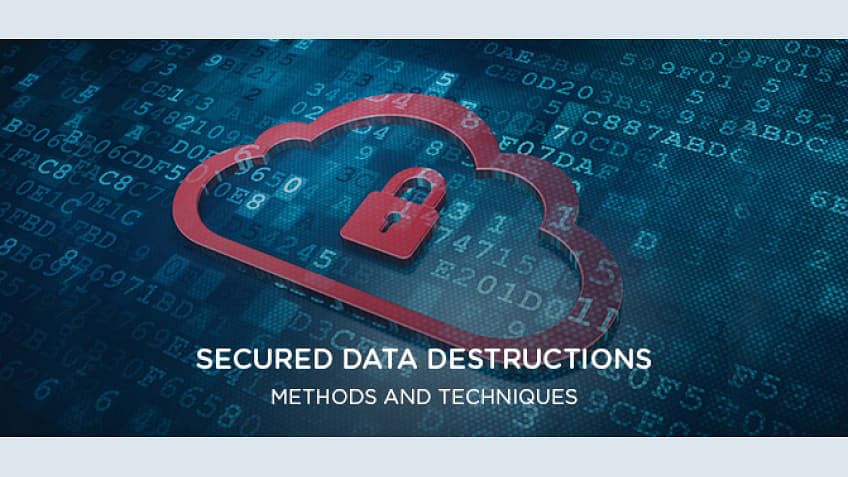Discovering the Value of Information Damage in the Context of Computer Protection Solutions and Protecting Confidential Data
In a period where data violations are significantly typical, the significance of efficient information devastation can not be overemphasized. Organizations needs to adopt rigid actions to guarantee that delicate information is not only shielded during its lifecycle however additionally decisively gotten rid of when no much longer essential. The approaches employed for data eradication, coupled with compliance to legal criteria, play a pivotal function in keeping confidentiality and count on. However, the effects of these practices extend beyond mere compliance, influencing a firm's credibility and operational stability in the electronic industry. What techniques can companies carry out to improve their information destruction procedures?
Understanding Data Devastation
Data damage is a vital component of computer protection that entails the long-term removal of information from storage space devices to avoid unapproved accessibility and prospective data violations. In a progressively electronic landscape, organizations face enhanced risks linked with delicate info being poorly accessed or exploited. Effective data damage safeguards versus these risks, guaranteeing that personal dataâEUR" such as client info, intellectual building, and economic recordsâEUR" can not be recouped after disposal.
Understanding the significance of information destruction prolongs beyond plain conformity with regulative and legal frameworks; it is essential for maintaining organizational integrity and depend on. When information is poorly taken care of or improperly ruined, the consequences can be extreme, consisting of economic loss, reputational damage, and lawful responsibilities.

Techniques of Information Obliteration

One prevalent approach is data cleaning, which includes overwriting existing data with random patterns numerous times. This method provides the initial data irretrievable, making it a prominent selection for companies seeking to secure secret information.
An additional method is degaussing, which uses an effective electromagnetic field to disrupt the magnetic domain names on storage space tools, effectively eliminating the data. This strategy is particularly reliable for magnetic media however is not suitable to solid-state drives.
Physical devastation is another robust method, involving the shredding or squashing of storage devices. This method warranties that data recovery is basically difficult, making it perfect for extremely sensitive details.
Last but not least, encryption can act as a corresponding method to information removal. By encrypting information prior to deletion, companies can add an added layer of protection, making certain that even if remnants are recouped, they stay unattainable without the decryption trick. Each technique needs to be chosen based upon the level of data level of sensitivity and the particular safety requirements of the company.
Legal Conformity and Data Safety And Security
Organizations should browse a complex landscape of lawful needs associated with information protection, particularly after applying methods of information elimination. Numerous laws, such as the General Data Defense Policy (GDPR) and the Wellness Insurance Coverage Transportability and Responsibility Act (HIPAA), enforce stringent standards on just how organizations need to deal with and get rid of of sensitive information. Failing to abide by these guidelines can result in significant lawful effects, consisting of significant fines and reputational damages.
Information destruction procedures should be meticulously documented to show conformity with suitable regulations and criteria. This paperwork not only functions as proof of adherence to legal commitments but also shows a dedication to securing sensitive info. Organizations should also develop clear policies regarding information retention and devastation timelines, making certain that data is not held longer than needed.

In addition, normal audits and analyses of data devastation practices are important to keep conformity and adapt to progressing legal structures (data destruction). By proactively dealing with legal demands, organizations can mitigate risks connected with information violations and show their dedication to data safety. Inevitably, focusing on legal compliance in data damage procedures is not simply a regulatory responsibility, but an essential element of a robust data safety strategy
Effect On Organization Online Reputation
The online reputation of a company can be considerably influenced by its Click This Link strategy to data damage and administration. In today's digital landscape, where data breaches can happen at any minute, the failing to properly throw away delicate info can lead to serious effects. Organizations that inadequately manage data devastation risk subjecting private customer info, which not just breaks privacy regulations however also erodes depend on amongst stakeholders and customers.
A ruined reputation can result in lowered consumer commitment, as clients come to be hesitant to engage with an organization that has actually shown oversight in safeguarding their data. In addition, negative attention bordering a data breach can have an enduring effect, as prospective customers could be deterred by the regarded lack of safety and security. This can lead to a straight decrease in earnings and market share.
Moreover, services that prioritize data devastation as part of their security strategy can boost their track record by showcasing their dedication to safeguarding delicate information. By adopting rigorous data monitoring practices, organizations can not only reduce dangers yet also place themselves as reliable entities in their corresponding sectors, consequently strengthening their overall brand photo.

Best Practices for Secure Disposal
Carrying out finest methods for protected disposal of information is crucial for mitigating threats related to information violations and making sure conformity with privacy policies. Organizations should adopt a thorough data disposal policy that details procedures for both physical and electronic information damage.
For physical data storage devices, such as disk drives, shredding or degaussing is suggested to prevent information healing. Furthermore, companies should preserve a chain of custodianship documents throughout the disposal process, making certain liability and traceability of disposed items.
For electronic data, utilizing you can check here software that sticks to sector standards for information cleaning is important. This software application needs to overwrite existing data numerous times, making recovery essentially impossible. It is additionally important to confirm the efficiency of the data damage procedure with audits or third-party evaluations.
Training employees on protected disposal practices adds another layer of protection, as human error can typically lead to data exposure. Consistently updating and examining disposal plans guarantees positioning with progressing guidelines and technical improvements. By applying these ideal techniques, organizations can considerably decrease the threat of unapproved data access and enhance their total data defense technique.
Conclusion
Finally, information destruction is a basic aspect of computer system security services that ensures the protection of private info from unapproved accessibility. Executing reliable approaches of information removal, adhering to lawful conformity, and recognizing the effect on business track record are essential parts of an extensive information safety technique. By taking on finest practices for safe disposal, organizations can cultivate depend on with customers and safeguard delicate data, eventually adding to a much more safe digital landscape.
In an era where information breaches are significantly typical, the relevance of effective data destruction can not be overemphasized.Information destruction is a critical element of computer system safety and security that involves the permanent removal of information from storage space gadgets to protect against unapproved accessibility and potential information violations. Organizations needs to also establish clear policies regarding information retention and damage timelines, making certain that information is not held longer than required.
By proactively addressing legal demands, organizations can reduce risks associated with data breaches and show their dedication to data safety (data destruction). Eventually, prioritizing legal conformity in information destruction processes is not just click for more info a regulatory obligation, however a basic facet of a durable data security strategy